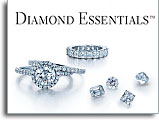

We would love to show you our various diamonds and exceptional custom jewelry.
Give us a call at 212.921.4221.

We not only sell diamonds, but we are experts in them as well. Sign-up to receive
our free newsletter.
 |
   

|
Diamond Buying Guide
Preparing you for your next diamond
purchase
It is important to learn
how a diamond gets it’s value before actually purchasing
your diamond. Read our guide and not only learn about the 4c’s;
Cut, Carat, Color, Clarity, read our insiders practical advice
as well.
|

The
4 C's: A practical guide
Ok let's start at the beginning.
What exactly are the "4 C'S" and how do they determine diamond
value? Here is a short rundown of the basics, each followed by
some real-life advice...
Each unique diamond crystal comes
out of the ground with its own set of hidden calculations to maximize
it's brilliance while retaining as much diamond weight as possible.
The Diamond's Brilliance, unfortunately, is often sacrificed by
some diamond cutters to keep the diamond as large as possible.
- In our opinion, the most important C is "Cut".
Cut refers to the level of craftsmanship in the diamond. Stones
that have been cut by skilled craftsman are brighter, have
more "scintillation" and are simply more attractive.
- The overall "Cut" of a diamond is comprised of
several components in the GIA grading report or "certificate".
- Symmetry - Alignment of facets, consistency
of angles and girdle thickness are some of the determining
factors of a diamond’s symmetry. The GIA grades
symmetry in the following order.
- Excellent , Very Good , Good , Fair , Poor
- Polish - The final critical step in
a diamond’s cutting process involves polishing each
facet as finely as possible. The GIA grades polish in
the following order.
- Excellent , Very Good , Good , Fair , Poor
- Cut Grade - Presently, only round stones
are assigned an overall cut grade by the GIA. GIA cut
grade is ranked as following.
- Excellent , Very Good , Good , Fair , Poor
- Practical Advice: Diamond Cut and Brilliance.
Beauty is in the eye of the beholder. This is why New York
Diamond Traders recommends you view a number of diamonds side
by side, in a professional diamond buying environment, before
you buy. There have been many attempts to quantify the beauty
of a diamond by assigning cut grades, performing light analysis,
and using complicated algorithms. Some of these methods do
a pretty good job, but nothing replaces actually viewing the
diamond in person and comparing them side by side. You do
not need to be a diamond professional, or have diamond experience
to know which diamond ‘talks’ to you. With New
York Diamond Traders professional guidance, anyone can see
which diamond is the most beautiful.
- Diamonds are sold by weight in units called carats. Five
carats equal one gram.
- Each carat contains 100 units called ‘points’.
So, a diamond that weighs exactly .50 Carats can be said to
weigh ‘50 points’( or a ‘50 pointer’
in the trade ).
- Practical advice: Carats and size.
- Diamonds get exponentially more expensive as they get
larger. For example, a single 3 carat diamond will cost
a lot more then 3 single one carat diamonds of the same
quality.
- Diamonds get more expensive as they hit certain weight
milestones. For example, a diamond weighing 1.85 carats
is significantly less expensive then a 2.00 carat diamond
of the same quality, and yet both diamonds will look very
similar in size. Diamonds that fall just shy of a weight
'milestone' can mean a big cost savings to you.
- Diamonds are graded for color. The "whiter" they
are, the more rare. "White" or "colorless"
refers to a desirable absence of any body color. The vast
majority of diamonds found in nature are brownish or tinted
a dull yellow. The rarest and highest diamond color grade
is D - the lowest is Z.
- Extremely yellow diamonds are called "fancy yellow"" and
are graded on a different scale. (The familiar term for "fancy
yellow" is "canary yellow"). These stones are quite desirable
and rare.
More on yellow diamonds
- Practical advice: Diamond Color. Generally
speaking, diamonds graded D through I or even some J colors,
appear white when set in a ring. You can get a significantly
larger and cleaner stone by choosing a near colorless diamond,
an H, I, or J color. The diamond will still face up white
without any traces of yellow, while staying in your budget.
- Please Note: Most often, only J colored diamonds with
GIA or AGS reports tend to face up white. J colored diamonds
with less respected laboratory reports are one to three
colors less then GIA. Viewing them in a proper diamond
buying environment is also crucial.

Clarity refers to the amount of minerals and other foreign
objects, or “inclusions”, trapped in the diamond
as it formed billions of years ago. The "cleaner"
diamonds are, the rarer. - FL, IF – Flawless and Internally Flawless: internal
inclusions can not be seen under 10x magnification
- VVS1, VVS2 -Very Very Slightly Included: Inclusions that
only the most experienced diamond professionals can spot when
using a microscope.
- VS1, VS2 - Very Slightly Included: Inclusions can be seen
with a hand held jewelers loupe. An inexperienced user will
have a difficult time spotting these tiny inclusions with
a loupe.
- SI-1, SI-2 - Slightly Included - Inclusions are easier to
spot with a loupe, but still not visible to the naked eye
almost
all the time.
- I1 and beyond - Included - Diamonds in the I1, I2 , and
I3 categories have inclusions that are easily visible to the
naked eye. While some I1 stones can occasionally be bright,
I2, and I3 diamonds have inclusions that are large enough
to affect its brilliance, and should be avoided.
- New York Diamond Traders sells Internally Flawless (IF)
through Slightly Included (SI) range only. Generally, we do
not recommend buying diamonds lower then the SI1-SI2 range
because they typically have eye visible inclusions.
- Practical Advice; Diamond Clarity. A common
misperception is the cleaner the diamond, the more brilliant
and attractive to the eye. This is true only in lower quality
ranges where diamonds typically have inclusions which may
affect transparency and brilliance. Diamonds in the upper
clarity ranges (SI-2 and better) can all be equally beautiful
and brilliant.
A practical strategy...
In our eyes - not all of the 4 C's are equally important. Here
are some practical steps that will help you make the right decision
before you get carried away with all the options.
- Determine your approximate budget.
- Determine the minimum carat weight you or your loved one
will be happy with.
- Set a minimum standard for color and clarity.
Once a minimum Carat, Clarity, and Color are established, and
your maximum budget is set your perfect stone will be easy to
find.
Of all the 4 C's the perfection of a diamonds cut is something
we do not believe you should compromise at all. New York Diamond
traders' collection of perfectly cut diamonds is unparalleled
in the industry. Please make an appointment
to view our extraordinary diamonds and let us guide you to the
perfect decision.
|
|









